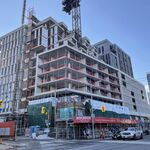$500M road to nowhere
Transit plan just glorified bike paths
By JOE WARMINGTON
Last Updated: 24th September 2008, 9:19am
What do you think we will see first -- new subway lines or new bike paths?
Since most of the already announced projects mentioned with this MetroLinx Big Move transportation plan yesterday never seem to get done. I am betting on bike paths.
Sure there's lots more talk about subway extensions to York University, a new rapid transit line along Eglinton, from Port Credit to Brampton, new transit for Yonge St., expanding the expressways and a lot of other things.
But in their news release on key projects, the only initiative that had a pricetag attached to it was the "investing up to $500-million over 25 years in new walking and cycling infrastructure creating more than 7,500 kms of new dedicated on and off-road facilities."
Just what this city needs. More bike paths. It's preposterous. Is that really how we should spend $500 million?
All you need to know about the motivation here is the order in how they place the "Eight Big Moves" -- or what they say "propose transformational changes to the way we get around."
The first "Big Move" on their list is "a fast, frequent and expanded regional, rapid transit network." Second is "a complete walking and cycling network with bike sharing programs."
A walking and cycling network is this city's second priority while "transit connections to Pearson Airport" is sixth.
Somebody has to tell Mayor David Miller and his green friends that biking is a hobby and that most people don't want to risk their lives to ride to work in an urban setting so he can get his face on the cover of another environmental magazine.
Flip over to page 29 and you can see what these cars-are-bad, bikes-are-good visionaries are really up to: "Plan and implement a complete, integrated walking and cycling network for the GTA, including Toronto's PATH system, that addresses key barriers to walking, such as bridges over 400 series highways and that brings every urban resident to within a maximum of one kilometre of a dedicated bicycling facility."
Are people supposed to walk in from Barrie, Hamilton and Oshawa and cross over the highways on one of these new bridges? Or are they supposed to ride their bikes over them? Will there be a toll?
"This will be supported by a provincial funding commitment increased over time to at least $20 million per year for municipalities to complete the network."
Does that $20-million budget in the plowing and salting in the winter? Ever ride a bike on black ice? I know a guy who has a steel rod in his leg who can tell you how treacherous it can be.
This crazy report has a whole "active transportation" section which includes "walking, cycling, roller-blading" and even spends a lot of space on creating a "pilot bike-sharing program."
These people have absolutely no concept of who is in the city, who lives here and who works here. I can guarantee nobody asked Iris Maraaganise what her transit concerns are.
I rode the bus with her yesterday east along Eglinton where she was heading to her nursing job.
She has been in Canada for five years from Zimbabwe and says "overcrowding" during rush hour on the bus is what makes her most uncomfortable.
Truth is, throw on a couple of extra buses and maybe you don't even need a "rapid line" along there. Hey, I just saved the taxpayer's millions. This whole problem is so simple to solve. Sometimes we just need more trains on and integrating the cost between the GO service and the TTC could be completed in 15 minutes. No need for more study and no need for any talk of more taxation after 2013 either.
Yesterday's Band-Aid approaches are just that -- political solutions and not practical ones.
Taking away driving lanes on Eglinton Ave. to put on so called "rapid transit" lines -- really nothing more than glorified street cars -- is craziness. If you want people out of their cars, don't build bike lanes, build proper subway lines.
We don't need phony "rapid transit networks" and "mobility hubs." We need a big-time transit system. It can't be that hard. "If we build it they will come," former transportation minister Frank Klees, now a Conservative critic, said. "But you have to build it."
So build it. Where appropriate, build new subway lines, new highways, new tunnels, bridges and whatever else you need to get commuters in and out of the city in the most efficient way.
We have the money. We have the know-how. We have the need.
The main job is getting people to work and then safely back home, where they can ride their bikes on the weekend.






